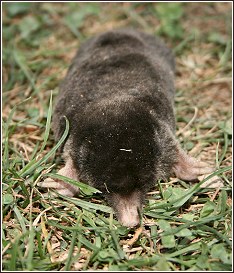Moles
Moles, Gophers and Voles are sometimes grouped into the same category, but in fact, there are distinct differences. Below, we look at just the mole - including types, behavior, reproduction, diet and biology. It's easier to control mole problems when you understand how they operate.
Mole Behavior, Biology And Diet
Moles belong to the mammal family Talpidae, in the order called Soricomorpha. Unlike gophers, moles are not rodents. Moles live underground; some are aquatic, and others are semi-aquatic. Moles are insectivores, (which means they eat insects) but they will also eat small animals on occasion. There are many wive's tails and misconceptions regarding mole control, but here are some facts you can count on.

Moles are fossorial, which means that they live mostly underground. Moles live underground in their tunnels. Some tunnel systems may be hundreds of feet long, interconnected territories whereas other systems may be smaller and less intricate. Some tunnel systems may allow for more than one "territory" whereas other moles may not allow others from adjacent labors.
Moles prefer loose, moist soil plump full of earthworms. If you water your lawn frequently, you are more susceptible to these furry little demons. This is because moles will gravitate towards the worms and worms favor moist soil. In other words, moist, well watered soil equals more moles at the surface causing damage.
There are many interesting facts about moles and gophers. For instance, moles have remarkable tunnel building abilities with physical characteristics that allow them to dig with a force over 30 times their own weight. As moles dig their tunnels deep into the ground, earth is pushed above the surface creating a pyramid like mound in a volcano shaped pile, called "mole dirt" or "mole hills". Mole hills are created when deeper tunnels are being made. You can see some mole hills from a mile away. You can spend a fortune on a landscaping service to manicure your lawn but all you will notice are those unattractive mole hills.

Moles have a high metabolic rate and must consume massive amounts of worms to fill it. Although it may appear they are eating your plant and grass roots, that is not their mission. They are actually after worms and in the process inadvertently kill grass by separating the roots from the soil leaving it to dry out and die. Not that it makes you feel any better, but the damage that moles cause to lawns is really 100% cosmetic. Although moles tend to get a really bad rap, they can be beneficial too, destroying bad bugs that can also cause damage to the roots of your grass and other plants. They also help your lawn by providing a source of valuable soil aeration. Just the same we understand that a mole can make you want to pull out your hair, especially when it destroys that expensive, beautiful lawn or garden you have worked so hard to produce.
Mole predators include dogs, cats, large fish, raccoons, minks, owls, hawks, foxes, skunks, and more.
Territorial Behavior
You can remove an entire group, also called a "labor", from any one given yard and within one day to one year's time have another labor move in to replace it. You can't destroy the tunnels effectively as their main tunnels are far enough down in the soil that a lawn roller or lawn compactor would never effectively reach them - and they just make more tunnels anyway, even after their tunnel system is destroyed. For the mole, their quest for food and destruction of your ever-so-precious lawn, except for breeding of course, is the only thing they care about.
Reproduction
Moles are capable of having one litter per year with approximately two to five young per litter. Moles create a nesting chamber, which is approximately 3 to 7 inches in diameter and is lined with foliage. With a gestation period of approximately 45 days, their young are typically born in March or April. Their young are able to take care of themselves in as little as four weeks. For homeowners, that means within four weeks of being born, moles can quickly be on the way to making your yard look like a zebra.
Common Types Of Moles In North America
There are six mole species in North America, the most common are the Eastern mole and the Star-nosed mole. Moles have short, thick hair and are easily identified by their unique large paddle-like front feet and short limbs. These paddles are utilized for digging their elaborate tunnel systems. Moles have cylindrical bodies with slim, flexible, pointy noses, and short tails which may or may not have hair. They have poorly developed eyes and ears that are not visible.
The Eastern Mole
The eastern mole (Scalopus aquaticus) is approximately 4.5 to 6 inches long and has a short tail with scant hair that is approximately 1 to 1.5 inches long. The mole's fur is very soft and velvety. The fur points up versus lying totally flat and going toward the tail. This allows the mole to move forward or backward inside their tunnels without their fur causing resistance. Similar to a duck, their fur keeps out dirt and water. Mole fur is gray in color. Bellies sometimes are a little lighter in color and they may have earth tone spots on them. The Eastern Mole usually breeds in January or February. After a four to six week gestation period, they generously produce 2 to 5 more troublemakers.
The Star-nosed Mole
The star-nosed mole (Condylura scristata) feels at home in moist soils. They enjoy soil around water sources such as streams and marshes. Their existence is more common in these geographic areas located in different parts of the country. The star-nose mole looks different than all other mole species and the most obvious physical difference is, on the tip of their noses, they have 22 nasty looking finger-like flesh-tone flanges similar to something like you would see in a grade B horror movie involving aliens. Just looking at them is enough to make a body cringe, even if you didn't know that it was simply that creature destroying your precious lawn.
The star-nosed mole is active all day and night searching through water, your front lawn and leaves for critters that include frogs, salamanders, minnows, crayfish, small animals, and of course, insects. These ravenous animals consume their food so fast that the human eye has a difficult time seeing it happen.
1242 SW Pine Island Rd., Suite 310
Cape Coral, Florida 33991-2126
help@totalwildlifecontrol.com















